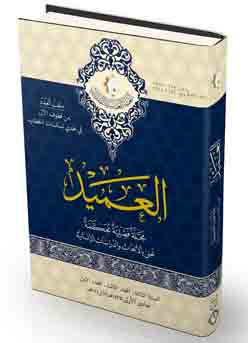Abstract
Due to the dominating non-human actions in the world, appealing
to rights has become a central concern of all humans. As such,
to bridge the gap between the idea, cultivation, and conventions
of human rights on the one hand and their realistic application on
the other has been of an extreme importance. Therefore, the study
aims at analysing two texts which are highly concerned with the
issue of rights, namely, the Universal Declaration of Human Rights
which was adopted and proclaimed in 1948 by the General Assembly
of the United Nations and Treatise on Rights 'Risalat Al-Huquq'
written by Imam Ali Al-Sajjad (p.b.u.h.) a principal figure in Islam
and the fourth imam of Shias in the 7th century. The analysis will
be carried out using an analytical framework of Critical Discourse
Analysis. Specifically speaking, the aims of the study are: investigating
the linguistic structure of the texts selected, exploring them
with respect to four interpretative procedures, and explicating their
ideologies. Consequently, it is hypothesised that the texts selected
although differ as to their linguistic structure, the texts that intertextually
they accord with, the speech acts they employ, and their
ideologies. Such an analysis reveals the linguistic as well as ideological
perspectives in which rights are presented in these two texts.
This, consequently, leads to the identification of power in these
texts which can be mainly achieved by the "ideological workings of
language", as proposed by Fairclough (1989: 2).
to rights has become a central concern of all humans. As such,
to bridge the gap between the idea, cultivation, and conventions
of human rights on the one hand and their realistic application on
the other has been of an extreme importance. Therefore, the study
aims at analysing two texts which are highly concerned with the
issue of rights, namely, the Universal Declaration of Human Rights
which was adopted and proclaimed in 1948 by the General Assembly
of the United Nations and Treatise on Rights 'Risalat Al-Huquq'
written by Imam Ali Al-Sajjad (p.b.u.h.) a principal figure in Islam
and the fourth imam of Shias in the 7th century. The analysis will
be carried out using an analytical framework of Critical Discourse
Analysis. Specifically speaking, the aims of the study are: investigating
the linguistic structure of the texts selected, exploring them
with respect to four interpretative procedures, and explicating their
ideologies. Consequently, it is hypothesised that the texts selected
although differ as to their linguistic structure, the texts that intertextually
they accord with, the speech acts they employ, and their
ideologies. Such an analysis reveals the linguistic as well as ideological
perspectives in which rights are presented in these two texts.
This, consequently, leads to the identification of power in these
texts which can be mainly achieved by the "ideological workings of
language", as proposed by Fairclough (1989: 2).
Keywords
Critical Discourse Analysis
ideological authority
ideology
individualism.
Intertextuality
modality
rights
schemata
Speech acts
transitivity
Abstract
نظرا للأفعال غير الإنسانية المهيمنة في العالم، اصبحت الدعوى للحقوق
والمناشدة بها مسألة اساسية لكل انسان. وأصبح التجسير بين فكرة حقوق
الانسان والدعوى لرعايتها و معاهداتها من جهة والتطبيق الحقيقي لهذا
من جهة اخرى ذا اهمية قصوى؛ لذا تهدف الدراسة الى تحليل نصين يعنيان
بمسألة الحقوق، هما الاعلان العالمي لحقوق الانسان الذي تبنته وأُعلنته في
عام ١٩٤٨ م الجمعية العامة للأمم المتحدة ، ورسالة الحقوق للإمام علي
السجاد )عليه السلام( وهو شخصية بارزة في الاسلام ورابع أئمة الشيعة
في القرن السابع الميلادي. وسوف ينفّذ التحليل باستخدام نموذج تحليل
تابع لحقل تحليل الخطاب النقدي. تحديدا. وهدف هذه الدراسة هو التحقق
في التركيب اللغوي للنصين المختارين واستكشاف النصين فيما يخص
اربعة اساليب تفسيرية و شرح ايديولوجياتهما. وتبعًا افترض ان النصين
المختارين يختلفان بالنسبة لتركيبهما اللغوي والنصوص التي يتفقان معهما
تناصيا والافعال الكلامية التي يوظفانها وايديولوجياتهما. وهذا يقود الى
تحديد سلطة هذين النصين التي يمكن احرازها من خلال "استعمال اللغة
.) ايديولوجيا" كما هو مقترح من فيركلوف ) ٢:١٩٨٩
والمناشدة بها مسألة اساسية لكل انسان. وأصبح التجسير بين فكرة حقوق
الانسان والدعوى لرعايتها و معاهداتها من جهة والتطبيق الحقيقي لهذا
من جهة اخرى ذا اهمية قصوى؛ لذا تهدف الدراسة الى تحليل نصين يعنيان
بمسألة الحقوق، هما الاعلان العالمي لحقوق الانسان الذي تبنته وأُعلنته في
عام ١٩٤٨ م الجمعية العامة للأمم المتحدة ، ورسالة الحقوق للإمام علي
السجاد )عليه السلام( وهو شخصية بارزة في الاسلام ورابع أئمة الشيعة
في القرن السابع الميلادي. وسوف ينفّذ التحليل باستخدام نموذج تحليل
تابع لحقل تحليل الخطاب النقدي. تحديدا. وهدف هذه الدراسة هو التحقق
في التركيب اللغوي للنصين المختارين واستكشاف النصين فيما يخص
اربعة اساليب تفسيرية و شرح ايديولوجياتهما. وتبعًا افترض ان النصين
المختارين يختلفان بالنسبة لتركيبهما اللغوي والنصوص التي يتفقان معهما
تناصيا والافعال الكلامية التي يوظفانها وايديولوجياتهما. وهذا يقود الى
تحديد سلطة هذين النصين التي يمكن احرازها من خلال "استعمال اللغة
.) ايديولوجيا" كما هو مقترح من فيركلوف ) ٢:١٩٨٩
